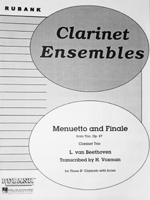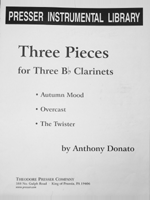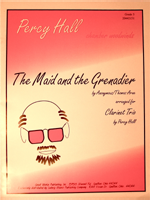Caboodles of Clarinets, Trios, Vol. 1

These trios for three B♭ clarinets are appropriate for intermediate to advanced clarinetists and also work well for casual classical gigs, sight-reading and adult amateurs. The three selections on this volume are all very different – an arrangement of British folk music, a brilliant Beethoven trio originally for two oboes and English horn and a modern work with three programmatic movements. Complete publishing information can be found below.
Tracks for each piece below are available separately as high-quality mp3 files.
Or, download the entire set (single zip file): Clarinet-Trios-Vol.-1

Ludwig van Beethoven; H. Voxman, transcription; Menuetto and Finale from Trio, Op. 87 for Clarinet Trio; Rubank, HL04479488
Ludwig van Beethoven (1770-1827)is probably best known for his famous Fifth Symphony and his unfortunate deafness. In 18th century Vienna, he was one of a long line of famous musicians, including Mozart, Haydn, Schubert, Brahms and many others. Beethoven wrote one opera and several choral works but mostly he wrote instrumental music. Folks who think about these things have noticed that his early works strongly resemble those of Mozart and Haydn (Beethoven’s Period of Imitation), Ludwig’s young adult music has a bold spirit (his Heroic Style Period), and his late-in-life compositions are more reflective (the Period of Introspection). What I have often wondered is why is it that Ludwig van Beethoven’s music seems to be the first of many composers to be so very closely related to his personal life story. I’ve come to believe that perhaps it is because he was the right person to come along at the right time – a true tragic and phenomenally talented character, born at the cusp of the most overtly emotional era of classical music history, the 19th century Romantic Era.Music historians define “Romantic” rather different than we might in the 21st century. Romanticism in the 1800s encompassed tragedy, heartbreak, revolution, death, madness and, oh yes, occasionally love but usually tragically so. Ludwig, for his personal romanticism, had an emotion-filled existence. He came very close to having the opportunity to study with Mozart in Vienna but just before the first lessons, Ludwig was call home to take care of his dying mother. He suffered the fate of many abused oldest children by both taking the brunt of the abuse and becoming the defender/caretaker of his mother and younger brothers. He proposed to several women whose fathers who thought Ludwig did not have the proper pedigree. He was even in Vienna when it came under attack (technically “cannon-balled”) by Napoleon’s army. Finally, the greatest tragedy – he lost his hearing just a few years after becoming a wildly popular pianist favored by the Vienna aristocrats. Really, the guy couldn’t win! Except for the fact that through it all, Beethoven was able to compose some of the most beautiful music ever written. Read more about Beethoven if you love a good story. There is a compelling movie that illustrates his life, with some fictional license, titled Immortal Beloved and a wonderful audio children’s story in the Classical Kids series, Mr. Beethoven Lives Upstairs. Check them out, he’s quite a character.The Trio in C major, Op. 87 was composed for 2 oboes and English Horn in 1795. It is a four-movement work, the Menuetto and Finale being the 3rd and 4th movements. (Under the Voxman Chamber Music for Three Clarinets, Vol. 2 I have also recorded the 2nd movement). The work has been arranged for many different instrumental combinations. This work is perhaps the most artfully constructed piece that I have recorded for this project, so do have a crack at it. There are several excellent recordings of this work. Two of my favorites are the two-oboe/English horn version by a group called, Triebensee: Elizabeth Starr, Kathryn Greenbank and Marylin Zupnik and a flute and string version by Claudio Ferrarini & the European Ensemble. If you are very ambitious and want to add a short cadenza at mm. 297-298 of the Finale, the Triebensee recording has a wonderful one that you could transcribe.
You can see the original score at imslp.org.
Menuetto: In preparing your individual parts before the first ensemble rehearsal, work your tempo both at the quarter note and then the dotted half. This menuetto is really a scherzo in terms of tempo, fast and rhythmically contrapuntal, and with three very independent musical lines, rather than two or three moving rhythmically together. My most comfortable tempo for my performance situation in which I wasn’t able to see my trio collaborators, was dotted half at 112 for the menuetto and 104 for the trio. No doubt you will find faster recordings, and you may settle on a slower tempo, but the meter feel definitely should be in one. The trio is especially problematic with that syncopation on count three throughout. The tendency is to be late on the entrance. You can counteract the problem by fading off the half note, so that your articulation and air are ready for the next attack. As well, the crescendo-decrescendoswells should be dramatic but shouldn’t adversely affect the tone and intonation. I do like to make the quarter notes without staccato dots as long as the tempo allows. Listen to mm. 65-83 in the 2nd and 3rd parts. I attempt to give the 1st part as much solid downbeat quarters with length against which to play the syncopation. Finally, a note about the wicked 3rd part from mm. 40-47 – drilling tempos, dotted rhythms, try alternate fingerings, various hand positions – and know that I feel your pain.Finale: In this movement I found a number of challenges in each part. In the 3rd part, the solo section and the syncopation that follows, mm. 72-85 – if there is a tendency, it will probably be that your are late on the entrances. Keep it in the pocket! The 2nd part, well your job is to sync perfectly with the 1st in the main melody and in the mm. 73-85 section, perfectly sync the off beats. Once you can do it, it is a wild & crazy ride. Metronome, lots of metronome practice. 1st clarinet part – this one is truly a technical show piece with the triplet sections. I used the suggested slur markings and worked towards a crisp, light staccato that is not overly percussive. When I perform this section I think of skipping lightly over running water. This keeps my finger and articulation movements coordinated and using minimal effort. All the parts in this movement are challenging.
01-Beethoven Menuetto from Trio Op 87 for Clarinet Trio complete version
02-Beethoven Menuetto from Trio Op 87 for Clarinet Trio minus 1st part
03-Beethoven Menuetto from Trio Op 87 for Clarinet Trio minus 2nd part
04-Beethoven Menuetto from Trio Op 87 for Clarinet Trio minus 3rd part
05-Beethoven Finale from Trio Op. 87 for Clarinet Trio complete version
06-Beethoven Finale from Trio Op 87 for Clarinet Trio minus 1st part
07-Beethoven Finale from Trio Op 87 for Clarinet Trio minus 2nd part
08-Beethoven Finale from Trio Op 87 for Clarinet Trio minus 3rd part
Download all eight tracks (single zip file)

Donato, Anthony; Three Pieces for Three B♭ Clarinets, Presser, 114-40032
Anthony Donato (1909-1990) was a composer and teacher (his most famous student is Joseph Schwantner) at Northwestern and several other universities.
1. Autumn Mood – Shaping the phrases is the most important factor in making this music work. Can you hear the crescendo/decrescendosthroughout? As well, balance between solo and supporting lines is crucial. Each part has a solo passage, so allow each one to come out of the texture. In terms of intonation, there are many minor chords to tune here, most obvious are those at mm. 17 and 31-34. Remember that our ears hear the minor chord in tune when the 3rd of the chord is sharp and the 5th is relatively pure. Those minor 3rds, the ‘D♭’ and the ‘C’, are both in the 2nd part.2. Overcast – I chose to record this one a bit faster than indicated (at 132). As always, you are encouraged to choose your best tempo, however, the ability of the 2nd and 3rd players to perform the upbeat rhythm will possibly determine your tempo. There is an interesting change from the hopping quality of the opening and at B to the lyrical section at A and the ending. I added a ritardando from around m. 47, then a fermata on m. 49. There also seems to be a natural ritard and fermataat the ending.3. The Twister – You may notice how thick and dark the texture of this movement is, with all the close harmonies and low clarinet sounds. We’ve performed this entire three-movement work with two B♭s and Bass Clarinet and it works well, especially with this movement. However, the key to making the 3 B♭ soprano clarinet version work is to have everyone play ‘in tune and in tone’ – correct intonation problems and listen for the articulation and the tone of the clarinet at different dynamic levels to make sure that no one player’s tone or dynamic level is above the others. We have Malory, an OWU alumnus of the 2010 clarinet trio to thank for the dynamic ideas at the end. I think the added dynamics make it much more exciting to perform and to hear.
09-Donato Anthony I Autumn Mood from 3 Pieces for 3 Bb Clarinets complete version
10-Donato Anthony I Autumn Mood from 3 Pieces for 3 Bb Clarinets minus 1st part
11-Donato Anthony I Autumn Mood from 3 Pieces for 3 Bb Clarinets minus 2nd part
12-Donato Anthony I Autumn Mood from 3 Pieces for 3 Bb Clarinets minus 3rd part
13-Donato, Anthony, II. Overcast from 3 Pieces for 3 Bb Clarinets, complete version
14-Donato, Anthony, II. Overcast from 3 Pieces for 3 Bb Clarinets, minus 1st part
15-Donato, Anthony, II. Overcast from 3 Pieces for 3 Bb Clarinets, minus 2nd part
16-Donato, Anthony, II. Overcast from 3 Pieces for 3 Bb Clarinets, minus 3rd part
17-Donato, Anthony, III. The Twister from 3 Pieces for 3 Bb Clarinets, complete version
18-Donato, Anthony, III. The Twister from 3 Pieces for 3 Bb Clarinets, minus 1st part
19-Donato, Anthony, III. The Twister from 3 Pieces for 3 Bb Clarinets, minus 2nd part
20-Donato, Anthony, III. The Twister from 3 Pieces for 3 Bb Clarinets, minus 3rd part
Download all twelve tracks (single zip file)

Hall, Percy; The Maid and the Grenadier; Great Works, 20442151
Percy Hall (b. circa 1930) is a music teacher from Mansfield, Ohio and a retired adjunct professor at Ashland University. As a member of the Mansfield Symphony he formed a Woodwind Trio that performed school concerts in the Mansfield public schools. I was on the tour one year and it was a truly a trip. One school had twenty or so hearing-impaired students and they all sat on the floor at our feet, some gently touching the bells of our clarinets to feel the vibrations as we played. I interviewed Percy about this work and the flute trio that I recorded and Mr. Hall had this to say about them, “I arranged these folk tunes [or composed in the style of a folk tune, as with the flute trio] because children were no long singing these great American folksongs and because at the time I was a band director and was disturbed at the lack of appropriate literature for small ensembles”. At 80+ years young, Mr. Hall is still excited about composing and arranging music as well as advocating for music education. You can visit his vast selection of publications at:
http://www.percyhall.com/
I. Polly Oliver: This movement, sometimes called ‘Sweet Polly Oliver’ or ‘Pretty Polly Oliver’, is an old English folksong about a girl who puts on her dead brother’s uniform and enlists in the army, volunteers to serve as a nurse only to find that her patient is her boyfriend. You may have played the band arrangement of this song by Thomas Root. It’s a lovely one and I find it to be especially enjoyable to perform and teach instrumental versions of folksongs. Here’s my suggestion: find the words (here they are on Wikipedia:
http://en.wikipedia.org/wiki/Sweet_Polly_Oliver) and sing along a phrase and a half (that’s all that the arrangement allows; try the last 6 lines) with my recording. Do you see how the clarinets’ phrasing matches the poetry? I did get rid of one breath, between mm. 12-13, for a little drama.There are lots of opportunities to work on tuning in this movement. The first phrase ends, at m. 4, with an F major triad (E♭ concert). Make sure that the root (3rd part) is
not flat (firm up embouchure, pull the bell in a bit), the 3rd of the triad (2nd part)
isa little flat (shade the open hole, right hand to bring the ‘a’ down) and the thumb ‘f’ is perfectly in tune with the low ‘f’. Each resting chord should be tuned carefully. Use your ears before looking at the tuner. If you want to learn more about tuning chords in woodwind ensembles, visit the video portion of this website. I also played a bit with the pacing of the folksong, pausing at the end of each line of poetry to feel the expanse of emotion and letting the end unfold slowly.
II. Rule, Britannia: Mr. Hall has arranged two famous English patriotic tunes here, ‘Rule Britannia’ (beginning) and ‘British Grenadiers’ (starting at m. 17). The first aspect that you might notice about this arrangement is the stately tempo. I did attempt, with all these recordings, to honor the instructions of the composers/arrangers. At times I recorded slower or faster than indicated but this one felt just right at quarter = 84. If you have ever been to London, the British guards
actually march this slowly. I was at the Tower of London at the changing of the guard and noticed that every movement the guard made was this ponderous. (Presumably, if anyone was literally stealing the coronation crowns housed there, they would move a bit quicker.) So, see if you can make it sound as proud and proper as a British grenadier’s march. Now on to style – Mr. Hall added many accents,
tenuto and
staccato markings here. These should be performed with similarity in all parts. The accents can easily be overdone, so go easy or the tone of the note may suffer.
Here’s a great English vocal/orchestra version, BBC Orchestra with Bryn Terfel of Rule Britania: http://www.cix.co.uk/~lumpkin/rulebrit.mp3
21-Hall, I. Polly Oliver from The Maid and the Grenadier, complete version
22-Hall, I. Polly Oliver from The Maid and the Grenadier, minus 1st part
23-Hall, I. Polly Oliver from The Maid and the Grenadier, minus 2nd part
24-Hall, I. Polly Oliver from The Maid and the Grenadier, minus 3rd part
25-Hall, II. Rule, Britannia from The Maid and the Grenadier, complete version
26-Hall, II. Rule, Britannia from The Maid and the Grenadier, minus 1st part
27-Hall, II. Rule, Britannia from The Maid and the Grenadier, minus 2nd part
28-Hall, II. Rule, Britannia from The Maid and the Grenadier, minus 3rd part
Download all eight tracks (single zip file)




